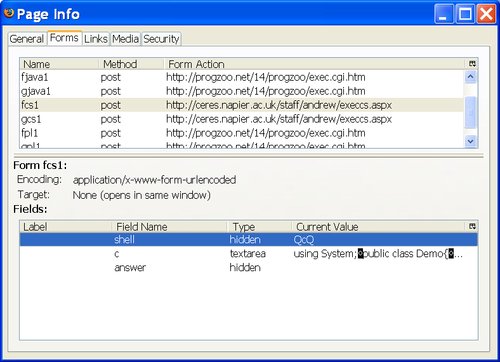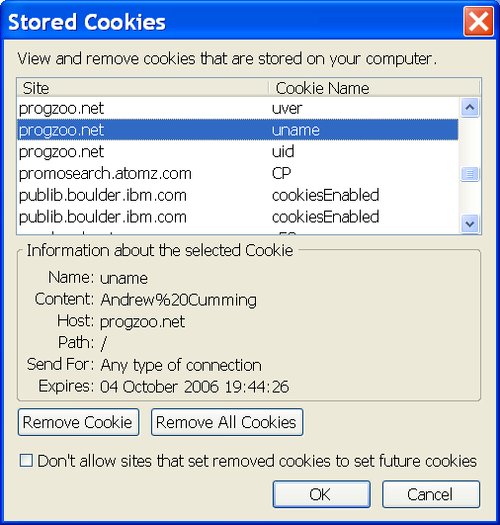Hack 48. Prevent an SQL Injection Attack


You can take steps to prevent an SQL injection attack. You can also minimize the consequences of an SQL injection attack.
Preventing an SQL injection attack is simply a matter of escaping values that come from web pages.
When you escape a string you replace special characters with escape sequences. For string input the only special character you need to worry about is the single quote. You must turn a string such as O'Reilly's into O''Reilly''s. Each single quote becomes two single quotes:
SELECT name FROM users WHERE name='O''Reilly' AND passwd='tiger'
If someone attempts an SQL injection attack [Hack #47] he could enter the magic string ' OR ''=' as both the username and the password. If you handle the input properly the result will be the perfectly legal and perfectly harmless SQL query:
SELECT name FROM users WHERE name=''' OR ''''=''' AND passwd=''' OR ''''='''
6.8.1. Escaping in Perl
In Perl you can ensure that such variables are dealt with properly by using placeholders in your SQL statements, as outlined in "Filter Rows and Columns" [Hack #8].
You can also use the $dbh->quote method. The sprintf function takes a format string followed by a number of parameters. The %s directives are replaced by these parameters in order:
my $dbh=DBI->connect('DBI:mysql:scott','scott','tiger');
$sql = sprintf "SELECT name FROM users WHERE name=%s AND passwd=%s",
$dbh->quote($Q::name), $dbh->quote($Q::passwd);
The quote method will use the appropriate quoting mechanism for the database that you are using. This might be '' or '.
6.8.2. Escaping in C#
In the .NET environment you can pass parameters to an SQL Server stored procedure, or you can escape the string yourself in C#.
String.Format is ideal for the job, when coupled with the Replace method. You might prepare an SQL statement as follows:
String sql = String.Format(
"SELECT name FROM users WHERE name='{0}' AND passwd='{1}'",
name.Replace("'","''"),
passwd.Replace("'","''")
);
The {0} and {1} placeholders get replaced with the second and third parameters of the Format method.
6.8.3. Escaping in PHP
In PHP, you can use mysql_real_escape_string(name) if you are using the mysql library. A better solution is to use Pear's DB module, and you can find out how to do this in Hack #35, Create Bulletproof Database Access, in PHP Hacks by Jack Herrington (O'Reilly). The same book also has useful information on storing encrypted passwords (Hack #57, Create a Login System) and fixing a weak password system (Hack #59, Migrate to MD5 Passwords).
6.8.4. Escaping in Java
In Java you can use the replaceAll string method:
name.replaceAll("'","''")
6.8.5. Nonstring Data
You must take care to ensure that all values coming in over the Web are properly checked. If you are expecting a number, you should check that it is composed of digits only. If you don't check that, the numeric input can easily be used to launch an SQL injection attack.
Even if you are not concerned about SQL injection, you should check the data format before putting it into an SQL statement because a runtime error generated by a type mismatch can have a disproportionate cost in terms of server load.
6.8.6. JavaScript Validation, Cookies, and Hidden Variables
You can have JavaScript validation and size limits on fields in the HTML, but do not expect these to protect your system. A user could save your form page on her desktop. She could then edit her version of your page and alter or disable the JavaScript and field size limits.
Also beware of hidden variables and cookies. Under normal circumstances, your scripts control these values, but it is not at all difficult for someone to make up her own values. An external user can view all of the hidden variables and cookies associated with a web page from Firefox, for instance. Look in Tools Page Info
Page Infoimages/U2192.jpg border=0>Forms for the variables, including hidden variables, as shown in Figure 6-18. Look in Tools
images/U2192.jpg border=0>Options
images/U2192.jpg border=0>Privacy
images/U2192.jpg border=0>Cookies
images/U2192.jpg border=0>View Cookies for the cookies, as shown in Figure 6-19.
Figure 6-18. Listing variables, including hidden variables

Figure 6-19. Listing cookies associated with a page

6.8.7. Exploits Using Hidden Variables and Cookies
An SQL injection attack based on hidden variables is not any more difficult than one using visible components, such as textboxes or a password. You can't do this directly from the web browser, but you can set variables as you choose if you use a command-line prompt utility such as lwp-request or wget. See Spidering Hacks by Kevin Hemenway and Tara Calishain (O'Reilly) for information on how to do this.
6.8.8. Restrict the Rights of the SQL Account
As well as preventing SQL injection attacks by escaping, it is sensible to limit the privileges of the account that you use to access your SQL system. It is good practice to ensure that the account being used has exactly the right permissions required and no more.
6.8.9. Don't Overreact
The basic SQL injection attack will not reveal your SQL user password or your operating system passwords. Only data in the database is exposed. It may be possible for someone to obtain an encrypted version of your SQL account password, but if you have chosen a sound password, that does not constitute a threat.
You should not underestimate the power of an SQL injection attack, but neither should you overestimate it. My site, http://sqlzoo.net, is vulnerable to SQL injection attacks by its very nature, and it has been running fairly smoothly for several years. I can't guard against SQL injection because I allow users to execute any SQL command they want against several different SQL engines. I use SQL GRANT and REVOKE commands to hide the tables I don't want users to see, and I deny write permission to the tables that I want users to see but not to change.
6.8.10. See Also
- "Exploit an SQL Injection Vulnerability" [Hack #47]
- "Implement Application-Level Accounts" [Hack #90]
- "Find and Stop Long-Running Queries" [Hack #98]
SQL Fundamentals
- SQL Fundamentals
- Hack 1. Run SQL from the Command Line
- Hack 2. Connect to SQL from a Program
- Hack 3. Perform Conditional INSERTs
- Hack 4. UPDATE the Database
- Hack 5. Solve a Crossword Puzzle Using SQL
- Hack 6. Dont Perform the Same Calculation Over and Over
Joins, Unions, and Views
- Joins, Unions, and Views
- Hack 7. Modify a Schema Without Breaking Existing Queries
- Hack 8. Filter Rows and Columns
- Hack 9. Filter on Indexed Columns
- Hack 10. Convert Subqueries to JOINs
- Hack 11. Convert Aggregate Subqueries to JOINs
- Hack 12. Simplify Complicated Updates
- Hack 13. Choose the Right Join Style for Your Relationships
- Hack 14. Generate Combinations
Text Handling
- Text Handling
- Hack 15. Search for Keywords Without LIKE
- Hack 16. Search for a String Across Columns
- Hack 17. Solve Anagrams
- Hack 18. Sort Your Email
Date Handling
- Date Handling
- Hack 19. Convert Strings to Dates
- Hack 20. Uncover Trends in Your Data
- Hack 21. Report on Any Date Criteria
- Hack 22. Generate Quarterly Reports
- Hack 23. Second Tuesday of the Month
Number Crunching
- Number Crunching
- Hack 24. Multiply Across a Result Set
- Hack 25. Keep a Running Total
- Hack 26. Include the Rows Your JOIN Forgot
- Hack 27. Identify Overlapping Ranges
- Hack 28. Avoid Dividing by Zero
- Hack 29. Other Ways to COUNT
- Hack 30. Calculate the Maximum of Two Fields
- Hack 31. Disaggregate a COUNT
- Hack 32. Cope with Rounding Errors
- Hack 33. Get Values and Subtotals in One Shot
- Hack 34. Calculate the Median
- Hack 35. Tally Results into a Chart
- Hack 36. Calculate the Distance Between GPS Locations
- Hack 37. Reconcile Invoices and Remittances
- Hack 38. Find Transposition Errors
- Hack 39. Apply a Progressive Tax
- Hack 40. Calculate Rank
Online Applications
- Online Applications
- Hack 41. Copy Web Pages into a Table
- Hack 42. Present Data Graphically Using SVG
- Hack 43. Add Navigation Features to Web Applications
- Hack 44. Tunnel into MySQL from Microsoft Access
- Hack 45. Process Web Server Logs
- Hack 46. Store Images in a Database
- Hack 47. Exploit an SQL Injection Vulnerability
- Hack 48. Prevent an SQL Injection Attack
Organizing Data
- Organizing Data
- Hack 49. Keep Track of Infrequently Changing Values
- Hack 50. Combine Tables Containing Different Data
- Hack 51. Display Rows As Columns
- Hack 52. Display Columns As Rows
- Hack 53. Clean Inconsistent Records
- Hack 54. Denormalize Your Tables
- Hack 55. Import Someone Elses Data
- Hack 56. Play Matchmaker
- Hack 57. Generate Unique Sequential Numbers
Storing Small Amounts of Data
- Storing Small Amounts of Data
- Hack 58. Store Parameters in the Database
- Hack 59. Define Personalized Parameters
- Hack 60. Create a List of Personalized Parameters
- Hack 61. Set Security Based on Rows
- Hack 62. Issue Queries Without Using a Table
- Hack 63. Generate Rows Without Tables
Locking and Performance
- Locking and Performance
- Hack 64. Determine Your Isolation Level
- Hack 65. Use Pessimistic Locking
- Hack 66. Use Optimistic Locking
- Hack 67. Lock Implicitly Within Transactions
- Hack 68. Cope with Unexpected Redo
- Hack 69. Execute Functions in the Database
- Hack 70. Combine Your Queries
- Hack 71. Extract Lots of Rows
- Hack 72. Extract a Subset of the Results
- Hack 73. Mix File and Database Storage
- Hack 74. Compare and Synchronize Tables
- Hack 75. Minimize Bandwidth in One-to-Many Joins
- Hack 76. Compress to Avoid LOBs
Reporting
- Reporting
- Hack 77. Fill in Missing Values in a Pivot Table
- Hack 78. Break It Down by Range
- Hack 79. Identify Updates Uniquely
- Hack 80. Play Six Degrees of Kevin Bacon
- Hack 81. Build Decision Tables
- Hack 82. Generate Sequential or Missing Data
- Hack 83. Find the Top n in Each Group
- Hack 84. Store Comma-Delimited Lists in a Column
- Hack 85. Traverse a Simple Tree
- Hack 86. Set Up Queuing in the Database
- Hack 87. Generate a Calendar
- Hack 88. Test Two Values from a Subquery
- Hack 89. Choose Any Three of Five
Users and Administration
- Users and Administration
- Hack 90. Implement Application-Level Accounts
- Hack 91. Export and Import Table Definitions
- Hack 92. Deploy Applications
- Hack 93. Auto-Create Database Users
- Hack 94. Create Users and Administrators
- Hack 95. Issue Automatic Updates
- Hack 96. Create an Audit Trail
Wider Access
- Wider Access
- Sharing Data Across the Internet
- Hack 97. Allow an Anonymous Account
- Hack 98. Find and Stop Long-Running Queries
- Hack 99. Dont Run Out of Disk Space
- Hack 100. Run SQL from a Web Page
Index
EAN: 2147483647
Pages: 147
- Article 314 Outlet, Device, Pull, and Junction Boxes; Conduit Bodies; Fittings; and Handhole Enclosures
- Article 356 Liquidtight Flexible Nonmetallic Conduit Type LFNC
- Article 409: Industrial Control Panels
- Annex D. Examples
- Example No. D2(b) Optional Calculation for One-Family Dwelling, Air Conditioning Larger than Heating [See 220.82(A) and 220.82(C)]
